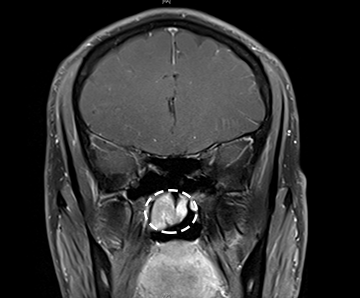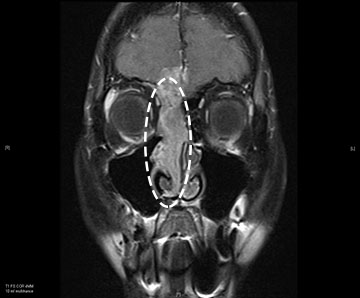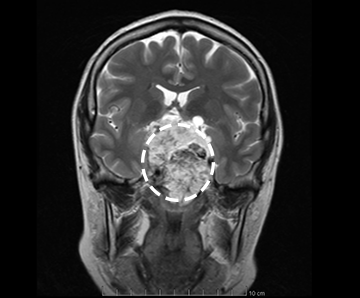Malignant Sinonasal Tumors
Overview
What are Malignant Sinonasal Tumors?
A malignant sinonasal tumor is a cancerous growth inside the nasal or sinus passages. These cancerous tumors can invade healthy tissue and spread to distant parts of the body. Malignant tumors can arise from any of the areas inside the nose or sinuses, including the lining, the blood vessels, the nerves, bone, and cartilage. If the tumor gets too large, it can affect your ability to breathe properly, as well as your sense of smell and vision.
Symptoms
Symptoms of Malignant Sinonasal Tumors
The symptoms of malignant sinonasal tumors depend on where the tumor is and what type of tumor it is.
Below are symptoms that may arise in association with where the tumor is located:
- Nasal cavity: Symptoms may include a mucous discharge, crusting within the nose, nasal obstruction, and nosebleeds.
- Maxillary sinus: The maxillary sinus is just below the eye; therefore, swelling in the cheek or just under the eye may be present.
- Frontal sinus: The frontal sinus is above the eye; therefore, swelling on the forehead above the eye may occur. If the tumor is large enough, the eye may be pushed down and vision can be affected.
- Ethmoid sinuses: The ethmoid sinuses are between the eyes, and a tumor here may push into the nasal cavity, causing a blockage. It may also push into the eye, displacing it from the eye socket, and cause double vision.
Other symptoms that may appear as the tumor grows include:
- Blocked sinuses that do not clear, or sinus pressure
- Headaches or pain in the sinus areas
- A runny nose
- Nosebleeds
- A lump or sore inside the nose that does not heal
- A lump on the face or roof of the mouth
- Numbness or tingling in the face
- Swelling or other trouble with the eyes, such as double vision or the eyes pointing in different directions
- Pain in the upper teeth, loose teeth, or dentures that no longer fit well
- Pain or pressure in the ear
Having one or more of these symptoms does not mean that you have a malignant sinonasal tumor. If you think you may have a malignant sinonasal tumor, call your doctor right away.
Causes
Causes of Malignant Sinonasal Tumors
There is no known direct cause for malignant sinonasal tumors. However, there is an association between squamous cell cancer and cigarette smoking, which may play a role if the malignant tumor is a squamous cell cancer.
Risk Factors
Risk Factors of Malignant Sinonasal Tumors
Anything that increases your chance of getting a disease is called a risk factor. Having a risk factor does not mean that you will get malignant sinonasal cancer; not having risk factors does not mean that you will not get malignant sinonasal cancer. If you think you may be at risk, you should talk to your doctor.
Risk factors for malignant sinonasal cancer include:
- Exposure to certain workplace chemicals or dust, such as those found in the following industries:
- Furniture-making
- Sawmill
- Woodworking (carpentry)
- Shoemaking
- Metal-plating
- Flour mill or bakery work
- Human papillomavirus (HPV)
- Smoking
Treatment
Treatment for Malignant Sinonasal Tumors
Most malignant sinonasal tumors will require surgery to remove the cancerous tissue. Some tumor surgery may be performed endoscopically. The term “endoscopic” refers to the use of small nasal telescopes that allow all of the surgery to be performed through the nostrils, without the need for any incisions on the face. Additional treatment for cancer may include radiation therapy, chemotherapy, or both.

Hemangiopericytoma
Click to Learn More

Squamous Cell Carcinoma (SCC)
Click to Learn More

Melanoma
Click to Learn More

Adenoid Cystic Carcinoma (ACC)
Click to Learn More

Small Cell Neuroendocrine Carcinoma (SNEC)
Click to Learn More

Chordoma
Click to Learn More

Sinonasal Undifferentiated Carcinoma (SNUC)
Click to Learn More

Esthesioneuroblastoma
Click to Learn More


